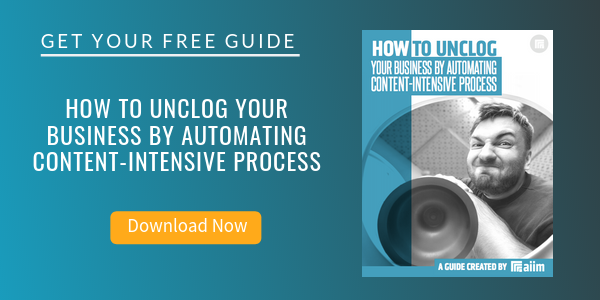
8 Things You Need to Know about Business Process Automation and Workflow
Process Automation | Business Process Management (BPM)
While document scanning and document management technologies and services successfully eliminate paper problems, it’s workflow automation that generates the greatest return on investment because this is where business processes are truly streamlined.
This is a guide for how to ease the pain of document-intensive business processes with workflow automation in a way that maximizes ROI, generates some quick wins and can lead to higher profitability and perhaps even competitive advantage.
1. Identify the Source of Your Pain
The first step to solving a problem is to admit that you have a problem by identifying critical business issues. Common business pain that can be addressed through workflow automation includes:
- High costs and error rates due to employee inefficiency and manual processes
- Duplicate or late payments, missing early pay discounts, and losing invoices
- Paying for goods and services not received
- High invoice aging and poor cash flow
- Fines for not having complete and proper documentation for employees, like I-9 forms
- Not being able to find documents quickly during an audit or lawsuit or not being able to find all documents
- Lengthy or incomplete new employee or new account on-boarding
- Hiring freezes while needing to get more done
- Lack of management visibility into business processes
- Poor customer service
Do any of these sound familiar? If so, then you’ve got some streamlining to do…
2. Understand the Rules of Engagement
One of the most important steps in automating any business process is to understand the rules of engagement, which include following rules, adhering to regulations, and following document retention requirements. This governance is established by a combination of internal corporate policies, external industry regulations and local, state, and federal laws. Regardless of the source, it’s important to be aware of their existence and how they affect the documents that drive your processes.
Of particular note, you need to understand the federally required retention schedule for employee records, which can range from 2-30 years — and indefinitely, in some cases. Below are some retention schedule examples. Because they can change, this is not a comprehensive list and may be trumped by state or industry guidelines. We recommend consulting with a certified records manager before creating a records retention policy and specific guidelines. Usually your document management partner can help you or refer you to a specialist. The industry trade groups ARMA and ICRM are both good resources for additional information on records management.
- FMLA records: three years
- INS I-9 forms: three years after date of hire or one year after date of termination (whichever is later) or indefinitely for foreign workers on visas
- Payroll records: three years
- Drug tests: five years (records pertaining to the process: only two years)
- OSHA forms 300, 300A & 301: five years
- Health records: six years
- Exposure to hazardous materials records: 30 years
- Benefits plans and pension documents: indefinitely
3. Document Your Process to Process Your Documents
The next step is to document where you are today. What documents need to be captured? Where do they come from and in what format are they? (i.e. paper, fax, email, PDF) Who needs to be involved in their processing? How do rules and regulations affect the process? How can this be done in a better way? What exceptions are there to the processes and how should they be handled?
Documenting your processes allows you to gain clarity and determine the sources of inefficiency, bottlenecks, and problems. You can then re-design the process to focus on the desired result with workflow automation. An easy way to do this is to sketch the processes on a piece of paper, possibly in a flowchart format. Visio or even Word can be used to create flowcharts easily.
The biggest mistake an organization can make is to replicate their manual, error-prone processes with technology. If you’re going to invest in hardware, workflow software, and professional services, you need to re-create the process by taking advantage of what this new technology allows, especially that which was not possible before with a manual process.
4. Be SMART & Define Your Goals
After clarifying your critical business issues and fully understanding the external and internal rules governing your documents, you’ll want to determine the key objectives of your process improvement activities.
When determining goals, being bold is one thing, but being SMART is another; remember that goals need to be:
- Specific
- Measurable
- Attainable
- Relevant
- Timely
For example, you may want to determine which vendors offer early payment discounts, how much could be saved if they were taken advantage of, and if you’ve got the cash flow to do so —then you can also determine vendor priority for who gets paid sooner rather than later.
Another example is to determine average invoice aging per customer. You can set an overall average, say 45 days down from 60 days, as well as identify goals per key customers who tend to pay late. This alone can dramatically improve cash flow.
5. Find an Office Automation Partner
Utilizing document imaging and enterprise content management (ECM) technology to automate business processes is best accomplished by working with an experienced office automation provider. But how do you find a good one to partner with?
You will want to find a company that:
- Can objectively evaluate your situation
- Has a depth of experience with your business process and solving your critical business issue
- Is able to recommend and implement a combination of hardware, software and services
- Can clearly articulate the value of every part of the proposed solution
Added Bonus: find a partner that will work with you in presenting a proposed solution to all of the stakeholders; senior management, end-users and even C-level executive leadership to simultaneously get buy-in from all groups and avoid scope creep later on.
6. Estimate ROI, Carefully
Unless they feel your pain directly, your superiors will likely be unmoved (and perhaps unimpressed) unless you present a compelling business case for moving forward with your workflow automation plans.
This business case needs to start with your partner’s proposal and include any other related internal costs. The trick is to identify how much money will be saved or made by implementing workflow and in what time frame. This may include:
Cost Savings
- Repurposing employees so new hires aren’t needed and FTE can be reduced
- Employee salary save by not having to replace those due to attrition
- The cost of space regained from paper, file cabinets, and bankers boxes
- Eliminating fines
- Reducing the cost of audits and lawsuits
- Taking advantage of early payment discounts and ending duplicate payments
- Ensuring complete documentation for a new account
Revenue Generation
- Collecting AR faster and improving cash flow
- On-boarding new accounts quicker
- Building business by providing superior levels of customer service
- Charging for instant access to records (e.g. public information, student transcripts, medical records)
Comparing solution costs with cost savings and revenues generated from workflow automation should lead to at least a conservative ROI. Be sure to tread carefully here: this estimated ROI is how the success of the solution—and you—will be judged, which is another reason to use a seasoned office automation partner.
7. Test & Re-Test for a Quick Win
Once you’ve identified the best workflow automation solution, it will be up to your partner to implement it. The best advice we can give during this step: keep out creep and keep an eye out for “quick wins” in early phases of the project. Everyone has an example of how a project that was supposed to take two to three months really took two to three years because of scope creep.
Additionally, focus on one business process and get a “quick win.” This can help build confidence, erode resistance and can keep your team properly motivated to tackle future projects.
Once implemented, you’ll want to test the new process to determine how well it works and identify where additional “exception processing” steps need to be included—then re-test and test again. In some cases, you may have thought that daily notifications were a good idea, only to find out that they quickly fill up your inbox, becoming a nuisance. Testing allows for these adjustments to be made prior to the official launch of the new process, which increases user adoption and decreases resistance to change. Documenting the final version of the process will help capture all of this hard work, thinking and experience, and can be used to train new people.
8. One Bite at a Time
How do you eat an elephant? One bite at a time. The same is true with business process automation. Start with one document intensive process, like accounts payable, then design, implement and test it successfully with your office automation partner. Make sure user acceptance is a high priority, as many technologies and new processes have failed due to employee resistance. Measure the resulting ROI. Then walk down the hall and implement in sales/customer service, HR, or any other area that could operate more efficiently.
Processing these documents with workflow automation represent the usual suspects:
|
|
Conclusion
Increasing efficiency, gaining visibility into your processes, and cutting costs starts with identifying your pain, then documenting your business processes, testing, and ends with a successful implementation of workflow automation. The Best Part: workflow solutions today are surprisingly affordable and offer very quick and measurable ROIs, particularly when coupled with document scanning services to handle capture and cloud document management.
About Mitch Taube
Over the past 20 years, Mitch has been helping companies improve efficiency and reduce costs by providing document scanning, document imaging, e-forms, workflow automation and document management software solutions. His current companies, Digiscribe International and Digiscribe New England, use best-of-breed document management software and a passionate and dedicated group of professionals to deliver these services. Their style is consultative in nature and their services are tailored to their customer’s needs.



